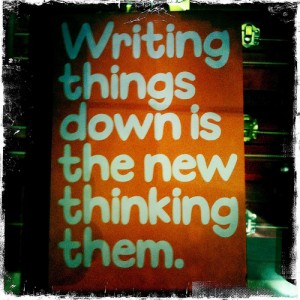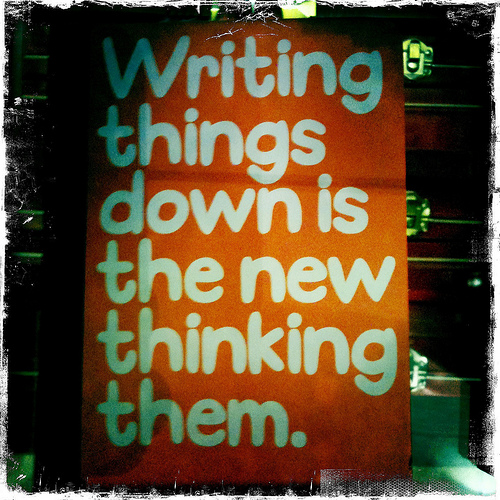
I just finished a beginner’s course on writing skills with one of my classes (first level in upper secondary school , the students are 16–17 years.)
The purpose was to teach the students different tools and approaches, that will be useful in a writing proces.
The students assignment was to write a “letter to the editor” of a newspaper or magazine of their own choice on a subject they chose themselves and actually send it in. Obviously, the goal is to see one’s opinions on printed paper — or on a online news site — and in a broader perspective (violins fade in) to let the students become responsible citizens in a living democratic community (violins fade out 🙂 ) .
The course consisted of 5 lessons:
1) The genre of “letter to the editor”
Students homework: Read about the genre “letter to the editor + pick 3 favorites on a online newspaper (I actually linked to our local newspaper, Herning Folkeblad’s editorial pages )
We looked at the basics of the genre. We talked a bit about do’s and dont’s. The basics of defamation laws and the difference between allegations and point of views in public debate.
The students discuss and compare the qualities of their picked letters. Arguments, style, language, titles.
We tried to come up with ‘do’s and dont’s ’ for our own writing to come.
2) Brainstorm and research

Student homework:
Think of an idea for a letter. It could be something that bugs you in your everyday life or in national or even world politics.
In class:
Then we try “speed writing” , a writer’s tool for generating ideas. The students think of their subject and have to write for 3 minutes without interruptions. I tell them to dim their screen or bend it over, so they can’t see what they are writing. Some students use handwriting, if that is faster for them.
The idea is to suppress/surpass the “inner critic”, that tells us that everything we write sounds stupid and makes us press the delete button.
After the 3 minutes, the students circle keywords in their text for use in a mindmap.
The students introduced me to Simplemind, a free and simple tool for creating mindmaps offline. If you want to share and cowrite a mindmap, you can use for instance Mindmup.
When the students have produced a mindmap, they swap laptops in pairs and help each other with more ideas.
Then it’s time for writing a “plan” for the letter, a list of paragraph’s titles. (I don’t know the English word — in Danish it’s ‘disposition’.)
If they finish early, they can do some net research and fact checking.
3) Feedback on ideas in first draft
Homework: The students should write a first draft and bring 3 printed copies to class. At home they should try speed writing for 10 minutes.
In class: The students meet up in groups of 4 and give each other feedback in turn. Everybody reads A’s text , give feedback and then move on to B. I tell them to ask questions in stead of critizing and also find something to appreciate.
This takes courage and a class culture of trust and respect. The teacher must teach some rules of coaching and giving response, and also talk about not taking feedback personally. But this is not easy, if you’re 16 and are used to writing exclusively for your teacher.
4) Group comment feedback on second draft in Google Drive

http://www.flickr.com/photos/pirateparrot/
Homework: Finish your letter and share it with your class mates in our Google Drive folder.
In class: The student groups writes feedback comments on another group’s letters. They could comment single words or paragraphs, and again, I told them to ask questions, or suggest alternate words or phrases, not criticize .
I told them to read one letter and then go for a 3 minute “monk’s stroll” in the school to discuss the letter and the feedback they should write. When they returned in class, the group commented in Google Drive with questions or advice. The author could decide for himself if he wanted to use the advice. (I have written elsewhere about using Google Drive in the classroom, in Danish though.)
The students liked the mix of sitting and walk-and-talking about the feedback.
They also appreciated their own feedback from class mates.
5) Editing and targeting
Homework : Choose 2 different newspapers or magazines and write two different titles for your letter. Which title fits the target group and why?
In class:
1) In pairs the students read and correct each other’s letters as it is impossible to see one’s own mistakes because of the way our brain works.
2) We look at different letters and discuss if titles and language fits the target group. When you have all the letters in Google Drive it is easy for the teacher to show the students texts on a projector. I change one or two words in a title and let the students see the difference or they suggest letters to discuss in class.
3) We discuss the subject of plagierism.
Is it plagierism to use help and feedback from peers, when you write your text? No!
Is it plagierism to copy-paste and present as your own work? Oh,yes.
My generation hold it as a self-evident truth, but the young people think of the internet as a big creative commons for everyone to drink from, like a public water reservoir. We have to adress it.
- and off the letters go! I don’t force my students to send it in. Must of them do, maybe in a few days.
A writing proces is a mix of solitary and social work, and mindmaps, speed writing and feedback from peers can help you over a writer’s block.
And by the way. This is my first blog in English. I ask my students to push their limits in order to evolve. Well, this is me walking the talk.
Obviously, I hope to connect with more teachers from exotic places, and maybe have a cup of coffee one day. 🙂


Skriv et svar